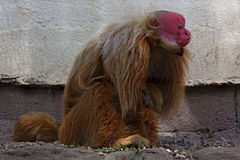Saki (małpy)
| Pitheciinae | |||||
| Mivart, 1865[1] | |||||
 Przedstawiciel podrodziny – samiec uakari szkarłatnego (Cacajao calvus) | |||||
| Systematyka | |||||
| Domena | |||||
|---|---|---|---|---|---|
| Królestwo | |||||
| Typ | |||||
| Podtyp | |||||
| Gromada | |||||
| Podgromada | |||||
| Infragromada | |||||
| Rząd | |||||
| Podrząd | |||||
| Infrarząd | |||||
| Parvordo | |||||
| Rodzina | |||||
| Podrodzina |
saki | ||||
| Typ nomenklatoryczny | |||||
|
Pithecia Desmarest, 1804 | |||||
| |||||
| Rodzaje | |||||
| |||||
Saki[9] (Pitheciinae) – podrodzina ssaków naczelnych z rodziny sakowatych (Pitheciidae). Wcześniej takson ten zaliczany były do płaksowatych (Cebidae).
Zasięg występowania
Saki występują w lasach północnej i centralnej Ameryki Południowej[10][11][12].
Charakterystyka
Żyją w stadach złożonych z kilku do kilkudziesięciu osobników obydwu płci[11].
Systematyka
Do podrodziny należą następujące występujące współcześnie rodzaje[13][10][9]:
Opisano również rodzaje wymarłe:
- Cebupithecia Stirton & Savage, 1951[14] – jedynym przedstawicielem był Cebupithecia sarmientoi Stirton & Savage, 1951
- Nuciruptor Meldrum & Kay, 1997[15] – jedynym przedstawicielem był Nuciruptor rubricae Meldrum & Kay, 1997
- Proteropithecia Kay, D. Johnson & Meldrum, 1999[16] – jedynym przedstawicielem był Proteropithecia neuquenensis (Kay, Johnson & Meldrum, 1998)
Uwagi
Przypisy
- ↑ St.G.J. Mivart. Contributions towards a more complete knowledge of the axial skeleton in the Primates. „Proceedings of the Biological Society of Washington”. 1865, s. 547, 1865. (ang.).
- ↑ J.E. Gray. On some new or little-known species of Monkeys. „Proceedings of the Zoological Society of London”. 17, s. 10, 1849. (ang.).
- ↑ a b J.E. Gray: Catalogue of Monkeys, Lemurs, and Fruit-eating Bats in the collection of the British Museum. London: The Trustees, 1870, s. 37. (ang.).
- ↑ H. Winge: Jordfundne og nulevende aber (Primates) fra Lagoa Santa, Minas Geraes, Brasilien: med udsigt over pungdyrenes slægtskab. F. Dreyer: Kjøbenhavn, 1895, s. 12, seria: E. Museo Lundii. (duń.).
- ↑ R. Anthony & P. Coupin. Tableau résumé ́d’une classification générique des Primates fossiles et actuels. „Bulletin du Museum national d’histoire naturelle”. 2e série. 3, s. 569, 1931. (fr.).
- ↑ P. Hershkovitz. A new genus of Late Oligocene monkey (Cebidae, Platyrrhini) with notes on postorbital closure and platyrrhine evolution. „Folia Primatologica”. 21 (1), s. 27, 1974. DOI: 10.1159/000155594. (ang.).
- ↑ a b F.S. Szalay & E. Delson: Evolutionary History of the Primates. New York: Academic Press, 1979, s. 293. ISBN 978-1-4832-8925-0. (ang.).
- ↑ a b H. Schneider, M.P.C. Schneider, I. Sampaio, M.L. Harada, M.J. Stanhope, J. Czelusniak & M. Goodman. Molecular phylogeny of the New World monkeys (Platyrrhini, Primates). „Molecular Phylogenetics and Evolution”. 2 (3), s. 235, tabela 3, 1993. DOI: 10.1006/mpev.1993.1022. (ang.).
- ↑ a b W. Cichocki, A. Ważna, J. Cichocki, E. Rajska-Jurgiel, A. Jasiński & W. Bogdanowicz: Polskie nazewnictwo ssaków świata. Warszawa: Muzeum i Instytut Zoologii PAN, 2015, s. 41–42. ISBN 978-83-88147-15-9. (pol. • ang.).
- ↑ a b C.J. Burgin, D.E. Wilson, R.A. Mittermeier, A.B. Rylands, T.E. Lacher & W. Sechrest: Illustrated Checklist of the Mammals of the World. Cz. 1: Monotremata to Rodentia. Barcelona: Lynx Edicions, 2020, s. 202–210. ISBN 978-84-16728-34-3. (ang.).
- ↑ a b S.F. Ferrari, L.M. Veiga, L.P. Pinto, L.K. Marsh, R.A. Mittermeier & A.B. Rylands: Family Pitheciidae (Titis, Sakis and Uacaris). W: R.A. Mittermeier, A.B. Rylands & D.E. Wilson (redaktorzy): Handbook of the Mammals of the World. Cz. 3: Primates. Barcelona: Lynx Edicions, 2013, s. 432–483. ISBN 978-84-96553-89-7. (ang.).
- ↑ D.E. Wilson & D.M. Reeder (redaktorzy): Subfamily Pitheciinae. [w:] Mammal Species of the World. A Taxonomic and Geographic Reference (Wyd. 3) [on-line]. Johns Hopkins University Press, 2005. [dostęp 2020-11-07].
- ↑ N. Upham, C. Burgin, J. Widness, M. Becker, C. Parker, S. Liphardt, I. Rochon & D. Huckaby: Treeview of Mammalian Taxonomy Hierarchy. [w:] ASM Mammal Diversity Database (Version 1.11) [on-line]. American Society of Mammalogists. [dostęp 2023-09-13]. (ang.).
- ↑ R.A. Stirton & D.E. Savage. A new monkey from the La Venta Miocene of Colombia. „Compilacion de los studios geol oficiles en Colombia, Servicio Geologico Nacional”. 7, s. 347, 350, 1951. (ang.).
- ↑ D.J. Meldrum & R.F. Kay. Nuciruptor rubricae, a new pitheciin seed predator from the Miocene of Colombia. „American Journal of Physical Anthropology”. 102 (3), s. 409, 1997. DOI: 10.1002/(SICI)1096-8644(199703)102:3<407::AID-AJPA8>3.0.CO;2-R. (ang.).
- ↑ R.F. Kay, D. Johnson & D.J. Meldrum. Proteropithecia, new name for Propithecia Kay, Johnson, and Meldrum, 1998 non Vojnits 1985. „American Journal of Primatology”. 47 (4), s. 347, 1999. DOI: 10.1002/(SICI)1098-2345(1999)47:4<347::AID-AJP6>3.0.CO;2-O. (ang.).
